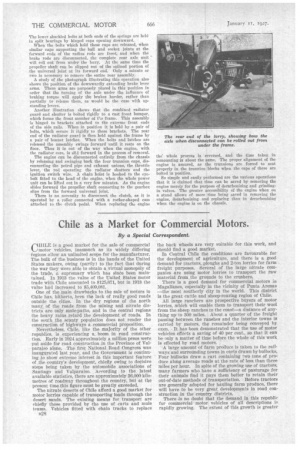Chile as a Market for Commercial Motors.
Page 48

Page 49

If you've noticed an error in this article please click here to report it so we can fix it.
By a Special Correspondent, CHILE is a good market for the sale of commercial tnotor vehicles, inasmuch as its widely differing tegions allow an unlimited scope for the manufacturer. The bulk of the business is in the hands of the United States makers, owing (partly) to the fact that during the war they were able to obtain a virtual monopoly of the trade, •a supremacy which has since been maintained. In 1913 the value of the United States motor trade with Chile amounted to 1$125,671, but in 1918 the value had increased to $5,409,081.
One of the main drawbacks to the sale of motors in Chile has, hitherto, been the lack of really good roads outside the cities. In the dry regions of the north many of the roads from the mining and nitrate districts are only mule-paths, and in the central regions the heavy rains retard the development of roads. In the south the scanty population does not render the construction of highways a commercial proposition. Nevertheless, Chile, like the majority of the other republics, is experiencing a boom in road construction. Early in 1924 approximately a million pesos were put aside for road construction in the Province of Valparaiso alone. The first National Road Congress was inaugurated last year, and the Government is continuing to show extreme interest in this important feature of the country's development, chiefly owing to decisive steps being taken by the automobile associations of Santiago and Valparaiso. According to the latest available statistics, there are approximately 36,000 kilometres of roadway throughout the country, hut at the present time this figure must be greatly exceeded.
The nitrate deserts of Chile afford a good market for motor lorries capable of transporting loads through the desert sands. The existing means for transport are chiefly those provided by the use of carts and mule teams. Vehicles fitted with chain tracks to replace B28 the back wheels are very suitable for this work, and should find a good market.
In Central Chile the conditions are favourable for the development of agriculture, and there is a good demand for tractors, ,ploughs and 2-ton lorries for farm freight purposes. Several of the large nitrate companies are using motor lorries to transport the raw material from the grounds to the crushers.
There is a good demand for commercial motors in Magallanes, especially in the vicinity of Punta Arenas —the most southerly city in the world. This district is the great cattle and sheep-rearing region of Chile.
All large ranchers are prospective buyers of motor lorries, which will enable them to transport their wool from the sheep ranches to the coast—a distance of anything up. to 300 miles. About a quarter of the freight passing between the ranehes and the interior towns is carried by motors, the remainder being conveyed by oxen. It has been demonstrated that the use of motor vehicles effects a saving of 40 per cent., so that it can be only a matter of time before the whole of this work is effected by road motors.
A large amount of farm produce is taken to the railways and surrounding towns in carts drawn by bullocks. Four bullocks draw a cart containing two tons of produce along average roads at the rate of less than three miles per hour. In spite of the growing use of tractors, many farmers who have a sufficiency of pasturage for their animals find it pays them better to retain their out-of-date methods of transportation. Before tractors are generally adopted for hauling farm produce, there will have to be very great developments in road construction in the country districts.
There ,is no doubt that the demand in this republic for commercial motor vehicles of all descriptions is rapidly growing. The extent of this growth is greater
than the import figures might suggest, for a very large number of vehicles is turned out in the country from the Ford factory at Santiago. Motor-omnibuses are seen in increasing numbers; at present there are considerably more than a thousand on the streets in Santiago alone.
In Chile, as in other Latin-American markets, the United States manufacturer owes much of his success to a most careful study of the market, the provision of highly efficient representation and a comprehensive spare parts service, plus a thorough Appreciation of the advantages of carefully planned and well-produced publicity matter drawn up in the language of the country.
Although the depression in the nitrate industry has, naturally, exercised a restricting influence on trade in general during the past year, it seems clear that the economic situation in Chile is steadily improving. The reorganization of the finances of the country and the stabilization of its currency are already inducing traders, who have adopted a " hand-to-mouth" policy in their buying, to substitute a policy of long-period contracts.
Add, further, the gradual modernization of methods of production and distribution—as exemplified by the application of mechanical transport in place of mules in the nitrate oficinas—and it becomes clear that Chile offers a substantial present and potential market and one that is worthy of serious consideration by the more enterprising and far-seeing concerns in the British commercial motor industry, particularly those which are ever ready to explore new markets abroad.




































































































